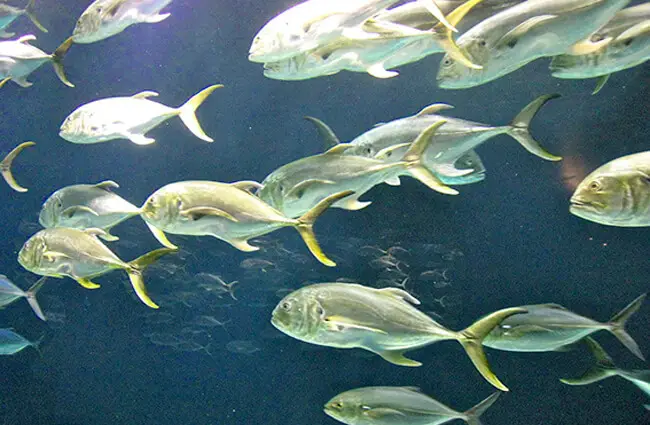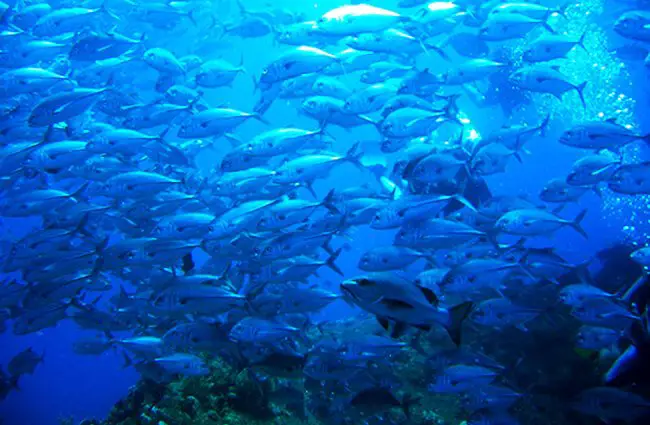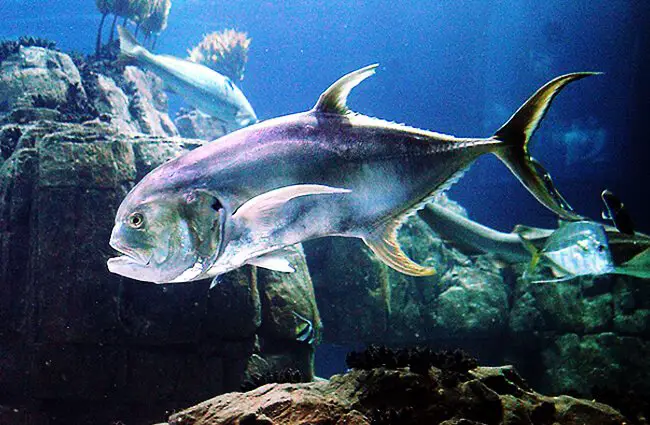Beneath the shimmering surface of the world’s tropical and subtropical oceans, a dynamic and powerful group of fish reigns supreme: the Jack Fish. Known for their sleek, torpedo-shaped bodies and formidable predatory prowess, these marine marvels are far more than just another finned creature. They are vital components of marine ecosystems, fascinating subjects for scientific study, and a testament to the ocean’s incredible biodiversity.
From the casual observer to the dedicated marine biologist, the Jack Fish offers a captivating glimpse into the intricate dance of life underwater. This comprehensive guide delves into the world of these remarkable fish, exploring their habitats, behaviors, evolutionary journey, and their multifaceted interactions with both the marine environment and human society.
Unveiling the Jack Fish: An Introduction to a Marine Powerhouse
The term “Jack Fish” broadly refers to a diverse family of marine fish, scientifically known as Carangidae. This family encompasses a wide array of species, including trevally, pompano, amberjacks, and scads, all sharing common characteristics that mark them as efficient ocean dwellers. They are typically recognized by their compressed, often silvery bodies, deeply forked tails, and a lateral line that may be armored with scutes near the tail.
These fish are renowned for their speed and agility, making them formidable predators and elusive prey. Their streamlined forms are perfectly adapted for life in open water, allowing them to navigate swiftly through currents and execute rapid strikes on their quarry. Whether encountered as a solitary hunter or as part of a vast, synchronized school, the presence of a Jack Fish invariably signals a vibrant and active marine environment.

Where the Jacks Roam: Habitat and Distribution
Jack Fish are cosmopolitan inhabitants of the world’s warm waters. Their primary domain spans the tropical and subtropical regions of the Atlantic, Pacific, and Indian Oceans. This widespread distribution is a testament to their adaptability and their ability to thrive in a variety of marine settings.
- Coastal Waters: Many species prefer coastal environments, including coral reefs, rocky shores, estuaries, and mangrove forests. These areas provide abundant food sources and shelter, particularly for juvenile fish.
- Open Ocean: Larger species and mature individuals often venture into the open pelagic zones, where they form vast schools and hunt in the blue waters.
- Depth Preference: While most Jacks are found in relatively shallow to moderate depths, some species can be found in deeper offshore waters, demonstrating a broad vertical range.
For an animal lover hoping to spot a Jack Fish in its natural habitat, coastal areas with healthy reef systems or seagrass beds in tropical regions offer excellent opportunities. Snorkeling or diving in places like the Caribbean, the Great Barrier Reef, or the Indo-Pacific will often reveal schools of Jacks gracefully navigating their underwater world.

Identifying a Jack Fish: Physical Characteristics
While the Carangidae family is diverse, several key features help in identifying a Jack Fish:
- Body Shape: Generally compressed and elongated, though some species can be more oval-shaped. Their bodies are built for speed and maneuverability.
- Coloration: Most Jacks exhibit silvery or metallic hues, often with darker backs and lighter bellies, providing effective camouflage in open water. Some species may display yellow fins or distinctive markings.
- Fins: They possess two dorsal fins, a long anal fin, and a deeply forked caudal (tail) fin, which is a hallmark of fast-swimming fish.
- Lateral Line: A prominent feature is the lateral line, which often has a series of bony scutes (plate-like scales) near the tail, particularly noticeable in species like the Crevalle Jack. These scutes provide protection and aid in hydrodynamic efficiency.
- Mouth: Their mouths are typically large and protractile, designed for capturing prey.
Observing these features can help distinguish a Jack Fish from other marine species, even for a casual enthusiast. Their powerful, athletic appearance is unmistakable.
The Hunter’s Instinct: Diet and Feeding Behavior
Jack Fish are primarily carnivorous predators, occupying a crucial position in the marine food web. Their diet varies depending on species, size, and habitat, but generally consists of:
- Smaller Fish: This is a staple for most Jack species. They are adept at hunting schooling baitfish such as sardines, anchovies, and herring.
- Crustaceans: Shrimps, crabs, and other invertebrates form a significant part of the diet for many Jacks, especially juveniles and species inhabiting coastal or reef environments.
- Cephalopods: Squid and octopus are also prey items, particularly for larger individuals.
Their hunting strategies are diverse and highly effective. Many species are opportunistic feeders, ambushing prey from cover or actively pursuing it in open water. Schooling Jacks often employ cooperative hunting tactics, herding baitfish into tight balls before taking turns to charge through the panicked mass, creating a spectacular feeding frenzy. This coordinated behavior highlights their intelligence and social complexity.

Deeper Dive: The Science and Significance of Jack Fish
For aspiring zoologists and students, understanding the intricate details of Jack Fish biology offers profound insights into marine ecology and evolution.
An Evolutionary Journey: Tracing the Jack Fish Lineage
The Carangidae family has a rich evolutionary history, with fossil records indicating their presence dating back millions of years. Their success can be attributed to several key adaptations:
- Hydrodynamic Design: The evolution of their streamlined bodies and powerful, forked tails allowed for exceptional speed and endurance, crucial for both hunting and escaping predators in open water.
- Schooling Behavior: The development of complex schooling behaviors provided significant advantages, including enhanced predator detection, confusion of predators, and improved foraging efficiency.
- Dietary Flexibility: Their ability to consume a wide range of prey, from small invertebrates to larger fish, allowed them to exploit diverse food sources across various habitats.
The Jack Fish lineage represents a highly successful evolutionary path within marine teleosts, demonstrating how specialized adaptations for speed, schooling, and predatory efficiency can lead to widespread distribution and ecological dominance in marine environments.
The Cycle of Life: Mating and Reproduction
The reproductive strategies of Jack Fish are typically characterized by broadcast spawning, a common method among many marine fish species. This process involves:
- Spawning Aggregations: Many Jack species form large spawning aggregations, often in specific locations such as offshore banks or reef edges, during particular times of the year, usually coinciding with warmer water temperatures and favorable lunar cycles.
- External Fertilization: Females release vast quantities of eggs into the water column, while males simultaneously release sperm. Fertilization occurs externally, relying on the sheer volume of gametes to ensure success.
- Pelagic Eggs and Larvae: The fertilized eggs are pelagic, meaning they float freely in the open ocean currents. They are typically small and transparent, developing into larvae that drift with the plankton. This dispersal mechanism helps distribute the species over wide areas and reduces competition with adult populations.
- Juvenile Development: As larvae grow, they undergo metamorphosis, developing into juvenile fish. These juveniles often seek shelter in coastal nurseries, such as estuaries, seagrass beds, or even beneath floating sargassum mats, where they are protected from larger predators and have access to abundant food.
- Maturity: Jack Fish typically reach sexual maturity within a few years, depending on the species and environmental conditions, before joining the adult populations and continuing the reproductive cycle.

Ecosystem Architects: Contribution and Interactions
Jack Fish play a pivotal role in marine ecosystems, acting as both significant predators and, particularly when young, as prey for larger animals.
- Top-Down Control: As active predators, Jacks help regulate populations of smaller fish and invertebrates, preventing overpopulation and maintaining the health and balance of their prey species. This top-down control is crucial for ecosystem stability.
- Food Source: Juvenile and smaller Jack species serve as an important food source for a wide array of larger marine predators, including sharks, dolphins, tuna, and various seabirds. They are a vital link in the marine food chain, transferring energy from lower trophic levels to higher ones.
- Nutrient Cycling: Through their feeding and waste products, Jack Fish contribute to nutrient cycling within their habitats, helping to distribute organic matter and essential elements throughout the water column and benthic zones.
Their schooling behavior also creates a dynamic interaction with other animals. Large schools of Jacks can attract a host of other predators, leading to spectacular feeding events that are a testament to the ocean’s raw power and interconnectedness.

Jack Fish and Humanity: Interaction and Cultural Significance
Human interaction with Jack Fish is extensive and varied, ranging from commercial exploitation to recreational appreciation and conservation efforts.
- Fisheries: Many species of Jack Fish are highly valued in commercial and recreational fisheries worldwide. Their firm, flavorful flesh makes them a popular food fish, particularly in Asian, Mediterranean, and Latin American cuisines. Species like the Yellowtail Amberjack and Crevalle Jack are prized by anglers for their fighting spirit.
- Aquaculture: While not as widely aquacultured as some other species, there is growing interest in farming certain Jack species to meet market demand and reduce pressure on wild stocks.
- Cultural Significance: In some coastal communities, Jack Fish may hold cultural significance, appearing in local folklore, art, or traditional fishing practices. Their abundance and importance as a food source often weave them into the fabric of maritime cultures.
- Conservation: Due to fishing pressure and habitat degradation, some Jack Fish populations face conservation concerns. Sustainable fishing practices, marine protected areas, and responsible consumption are crucial for ensuring the long-term health of these species and their ecosystems.
For a hiker encountering Jack Fish in the wild, perhaps while snorkeling or observing from a pier, the best course of action is respectful observation. Appreciate their beauty and power from a distance, avoid disturbing their natural behavior, and remember that their presence indicates a healthy marine environment worth protecting.
Caring for Jacks: A Zookeeper’s Guide to Captive Care
Keeping Jack Fish in a captive environment, such as a public aquarium, requires specialized knowledge and dedicated care due to their active nature, size, and predatory instincts.
Essential Tasks for Zookeepers:
- Spacious Environment: Provide a very large tank or exhibit with ample swimming space. Jacks are fast, schooling fish that require room to move freely to prevent stress and physical injury.
- Water Quality: Maintain pristine marine water conditions. This includes stable temperature (tropical range, typically 24-28°C or 75-82°F), appropriate salinity (around 1.023-1.025 specific gravity), and strict control over ammonia, nitrite, and nitrate levels through robust filtration and regular water changes.
- Diet and Feeding: Offer a varied diet of high-quality, appropriately sized marine proteins. This can include whole or chopped fish (e.g., silversides, mackerel), squid, and shrimp. Feeding should be regular and monitored to ensure all individuals receive adequate nutrition. Supplementation with vitamins may be necessary.
- Social Structure: If housing schooling species, maintain a group of several individuals to allow for natural social behaviors. Introduce new fish carefully to minimize aggression.
- Enrichment: While Jacks are active swimmers, providing some structural elements like large rocks or artificial reefs can offer visual interest and occasional shelter, though open swimming space remains paramount.
- Health Monitoring: Regularly observe fish for signs of stress, disease, or injury. This includes changes in swimming patterns, appetite, coloration, or the appearance of lesions. Prompt veterinary intervention is crucial.
What to Avoid in Captive Care:
- Overcrowding: This is a major stressor for active fish like Jacks, leading to poor water quality, increased aggression, and disease.
- Incompatible Tank Mates: Do not house Jacks with very small fish they might prey upon, or with overly aggressive species that could harass them. Choose tank mates that are similar in size, temperament, and environmental requirements.
- Sudden Environmental Changes: Avoid rapid fluctuations in water temperature, salinity, or pH, as these can severely stress fish.
- Poor Nutrition: A monotonous or low-quality diet can lead to nutritional deficiencies and weakened immune systems.
- Inadequate Filtration: Given their size and feeding habits, Jacks produce a significant bioload. Insufficient filtration will quickly compromise water quality.

A Huge List of Interesting Facts About Jack Fish
- Speed Demons: Many Jack species are among the fastest swimmers in the ocean, capable of incredible bursts of speed to catch prey or escape danger.
- Schooling Spectacles: Some species form massive schools, sometimes numbering in the thousands, creating breathtaking underwater formations that move with remarkable synchronicity.
- Ambush Predators: While known for open-water pursuit, many Jacks are also adept ambush predators, using reef structures or seagrass beds for cover before launching a surprise attack.
- Size Variation: The Carangidae family includes species ranging from small scads just a few inches long to giant trevally that can exceed 1.7 meters (5.5 feet) and weigh over 80 kilograms (176 pounds).
- “Jack Crevalle” Name Origin: The common name “Crevalle Jack” is thought to derive from the Portuguese word “cavala,” meaning mackerel, due to their similar appearance and schooling habits.
- Lateral Line Scutes: The bony scutes along their lateral line are not just for protection; they also help reduce drag and improve hydrodynamic efficiency during fast swimming.
- Pelagic Spawners: Their eggs and larvae drift in the open ocean, a strategy that maximizes dispersal and minimizes competition with adult populations.
- Juvenile Nurseries: Young Jacks often utilize sheltered coastal areas like estuaries and mangrove forests as crucial nursery grounds, providing protection and abundant food.
- Apex Predators in their Niche: Larger Jack species, like the Giant Trevally, are considered apex predators in many reef environments, influencing the entire food web.
- Highly Sought by Anglers: Their powerful fights and strong runs make them a favorite target for sport fishermen around the globe.
- Indicator Species: The presence of healthy Jack Fish populations can often be an indicator of a thriving and balanced marine ecosystem.
- Diverse Diets: While primarily piscivores, their diet can also include a wide range of crustaceans and cephalopods, showcasing their adaptability.
Conclusion: The Enduring Legacy of the Jack Fish
The Jack Fish, in all its diverse forms, stands as a powerful symbol of the ocean’s vitality and complexity. From their lightning-fast hunts to their synchronized schooling ballets, these fish are integral to the health and balance of marine ecosystems worldwide. Their evolutionary success, intricate life cycles, and significant interactions with other species and with humanity underscore their importance.
Whether you are a student delving into marine biology, an animal lover seeking to connect with nature, or simply someone captivated by the wonders of the underwater world, the Jack Fish offers endless opportunities for discovery and appreciation. Understanding and protecting these magnificent creatures is not just about preserving a single family of fish; it is about safeguarding the intricate web of life that sustains our planet’s most expansive and mysterious realm.

![Red Angus Closeup of a beautiful Red Angus cowPhoto by: U.S. Department of Agriculture [pubic domain]https://creativecommons.org/licenses/by/2.0/](https://animals.net/wp-content/uploads/2020/03/Red-Angus-4-238x178.jpg)




![Red Angus Closeup of a beautiful Red Angus cowPhoto by: U.S. Department of Agriculture [pubic domain]https://creativecommons.org/licenses/by/2.0/](https://animals.net/wp-content/uploads/2020/03/Red-Angus-4-100x75.jpg)

